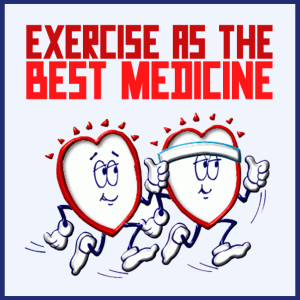So now that we have discussed the many benefits of exercise, how much is recommended? National organizations such as the American Heart Association (AHA) have created evidence-based guidelines describing the minimum amounts and types of physical in which adults should regularly engage.
AHA Guidelines
The American Heart Association defines physical activity as any movement of the body that burns calories. For the busy medical student, this can include climbing stairs, rounding on patients, or holding retraction for hours during surgery. The AHA recommends that adults engage in either 150 minutes of moderate exercise, 75 minute of vigorous activity, or some combination of both per week. In addition to this, moderate to high intensity resistance training twice a week is recommended. This exercise can be divided into installments of any duration, for example, two 15 minute exercise sessions three times per week can fulfill your exercise quota! Dividing exercise into short, high intensity sessions may seem easier than a long workout and more feasible to insert into busy schedules.
More specific guidelines are available for people with hypertension or hypercholesterolemia. Such patients should engage in moderate or vigorous intensity aerobic exercise for 40 minutes three or four times per week. This has been shown to lower their risk of stroke and heart disease, severe sources of morbidity and mortality in America.
Ideally, exercise should consist of a balance of aerobic and resistance training activities, since both offer unique benefits. This means long distance runners should add a weight lifting day into their routines to strengthen their bones, and body builders can lessen their chance of heart disease by incorporating cardio into their workouts.
Are Americans meeting these exercise guidelines?
According to the Center for Disease Control (CDC), only 1 in 5 Americans meet the national physical activity recommendations. This statistic was determined from an annual phone survey to Americans 18 years or older. Thus, despite the increased media attention on exercise in the past months, there is still work to be done, and physicians can play an important role in improving physical fitness throughout the country.
Are you meeting these exercise guidelines?
As health care providers, it is dually important that we are physically active, both for our own health and to serve as a role model to the many patients we care for on a daily basis. Engaging in physical activity and reaping its many benefits will make us more willing to regularly recommend it to our patients. During our medical training, we learn the physiology of the human body, the pathology of disease states and therapies to treat them. Throughout this process, a knowledge of how exercise influences physiology and pathology, and its use as a therapy, can enhance our understanding and utilization of this excellent preventative medicine.
The further I progress in my medical training, the more passionately I believe that exercise is the best preventive medicine. In this column, I share research regarding exercise as medicine, ways medical students can incorporate exercise into their daily routines, poetry on positive exercise experiences, and highlights on how doctors in the community are using exercise as a means to treat their patients.




